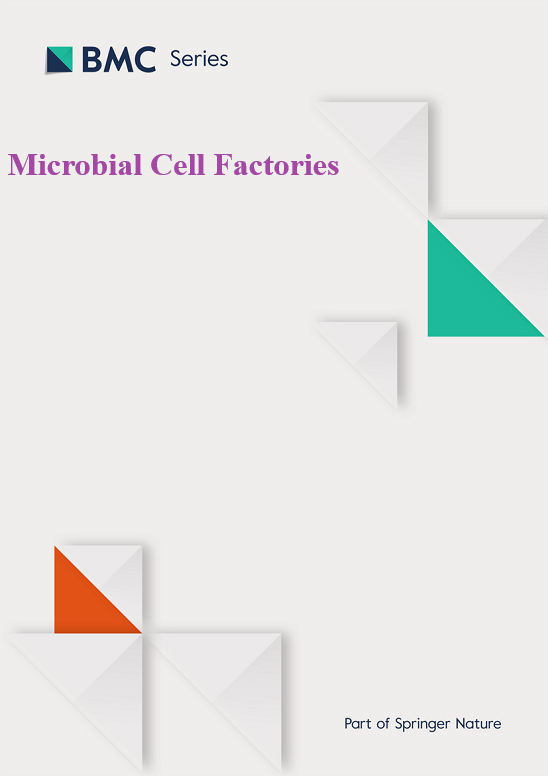电生假单胞菌的系统生物学--多组学见解和新陈代谢工程,促进 2-酮基葡萄糖酸盐的生产
IF 4.3
2区 生物学
Q1 BIOTECHNOLOGY & APPLIED MICROBIOLOGY
引用次数: 0
摘要
普氏假单胞菌 KT2440 已成为工业生物生产中一种很有前途的宿主。然而,它的好氧性限制了其应用范围。值得注意的是,这种微生物在缺氧生物电化学系统(BES)中培养时表现出很高的生物转化效率,在该系统中,阳极代替氧气成为终端电子受体。这种环境有利于合成具有商业吸引力的化学物质,包括 2-Ketogluconate (2KG)。为了更好地理解这种有趣的电生表型,我们通过多组学分析在系统水平上研究了 BES 培养菌株。受研究结果的启发,我们构建了新型突变体,旨在提高 2KG 的产量。在葡萄糖培养条件下,P. putida KT2440 不生长,但产生了大量 2KG,以及少量葡萄糖酸、乙酸、丙酮酸、琥珀酸和乳酸。13C 示踪研究表明,这些产物部分来自生物质碳,涉及蛋白质和脂质。随着时间的推移,细胞在转录组和蛋白质组水平上都发生了全面变化,包括翻译和细胞运动的停止,这可能是为了节约能量。这些适应性使细胞能够在数周内保持大量代谢活动。乙酸的形成被证明有助于能量供应。缺乏乙酸盐生成的突变体在滴度、产量和生产率方面都表现出更高的 2KG 产量。∆aldBI ∆aldBII 双缺失突变体表现最佳,其 2KG 的积累速度是野生型的两倍,产量也有所提高(0.96 摩尔/摩尔)。通过整合转录物组、蛋白质组和代谢组分析,这项研究首次从系统生物学角度揭示了 P. putida KT2440 的电生表型。对缺氧-电原条件的适应涉及能量代谢的协调变化,使细胞能够长时间维持代谢活动。代谢工程突变体有望在这些条件下提高 2KG 产量。醋酸合成的衰减代表了第一种以系统生物学为基础的代谢工程策略,可提高普氏菌的 2KG 产量。这种非生长缺氧-电生模式拓展了我们对普氏菌生长、葡萄糖磷酸化以及葡萄糖氧化成葡萄糖酸盐和 2KG 之间相互作用的理解。本文章由计算机程序翻译,如有差异,请以英文原文为准。
Systems biology of electrogenic Pseudomonas putida - multi-omics insights and metabolic engineering for enhanced 2-ketogluconate production
Pseudomonas putida KT2440 has emerged as a promising host for industrial bioproduction. However, its strictly aerobic nature limits the scope of applications. Remarkably, this microbe exhibits high bioconversion efficiency when cultured in an anoxic bio-electrochemical system (BES), where the anode serves as the terminal electron acceptor instead of oxygen. This environment facilitates the synthesis of commercially attractive chemicals, including 2-ketogluconate (2KG). To better understand this interesting electrogenic phenotype, we studied the BES-cultured strain on a systems level through multi-omics analysis. Inspired by our findings, we constructed novel mutants aimed at improving 2KG production. When incubated on glucose, P. putida KT2440 did not grow but produced significant amounts of 2KG, along with minor amounts of gluconate, acetate, pyruvate, succinate, and lactate. 13C tracer studies demonstrated that these products are partially derived from biomass carbon, involving proteins and lipids. Over time, the cells exhibited global changes on both the transcriptomic and proteomic levels, including the shutdown of translation and cell motility, likely to conserve energy. These adaptations enabled the cells to maintain significant metabolic activity for several weeks. Acetate formation was shown to contribute to energy supply. Mutants deficient in acetate production demonstrated superior 2KG production in terms of titer, yield, and productivity. The ∆aldBI ∆aldBII double deletion mutant performed best, accumulating 2KG at twice the rate of the wild type and with an increased yield (0.96 mol/mol). By integrating transcriptomic, proteomic, and metabolomic analyses, this work provides the first systems biology insight into the electrogenic phenotype of P. putida KT2440. Adaptation to anoxic-electrogenic conditions involved coordinated changes in energy metabolism, enabling cells to sustain metabolic activity for extended periods. The metabolically engineered mutants are promising for enhanced 2KG production under these conditions. The attenuation of acetate synthesis represents the first systems biology-informed metabolic engineering strategy for enhanced 2KG production in P. putida. This non-growth anoxic-electrogenic mode expands our understanding of the interplay between growth, glucose phosphorylation, and glucose oxidation into gluconate and 2KG in P. putida.
求助全文
通过发布文献求助,成功后即可免费获取论文全文。
去求助
来源期刊

Microbial Cell Factories
工程技术-生物工程与应用微生物
CiteScore
9.30
自引率
4.70%
发文量
235
审稿时长
2.3 months
期刊介绍:
Microbial Cell Factories is an open access peer-reviewed journal that covers any topic related to the development, use and investigation of microbial cells as producers of recombinant proteins and natural products, or as catalyzers of biological transformations of industrial interest. Microbial Cell Factories is the world leading, primary research journal fully focusing on Applied Microbiology.
The journal is divided into the following editorial sections:
-Metabolic engineering
-Synthetic biology
-Whole-cell biocatalysis
-Microbial regulations
-Recombinant protein production/bioprocessing
-Production of natural compounds
-Systems biology of cell factories
-Microbial production processes
-Cell-free systems
 求助内容:
求助内容: 应助结果提醒方式:
应助结果提醒方式:


